Welcome to Saxony-Anhalt, the bird lovers paradise! With an incredibly diverse array of habitats and a mild climate, Saxony-Anhalt is home to many different species of birds.
From the majestic White-tailed Eagle soaring over the Harz mountains to the native White Stork in the wetlands, Saxony-Anhalt is a birdwatcher’s paradise. There are many opportunities to spot rare and unusual species, such as the Black Kite, Red Kite, and Lesser Grey Shrike.
In addition, the vast forests are a haven for woodpeckers, owls, and other woodland birds. So come join us in Saxony-Anhalt and discover the incredible variety of birds that call this beautiful region home!
1. Mallard
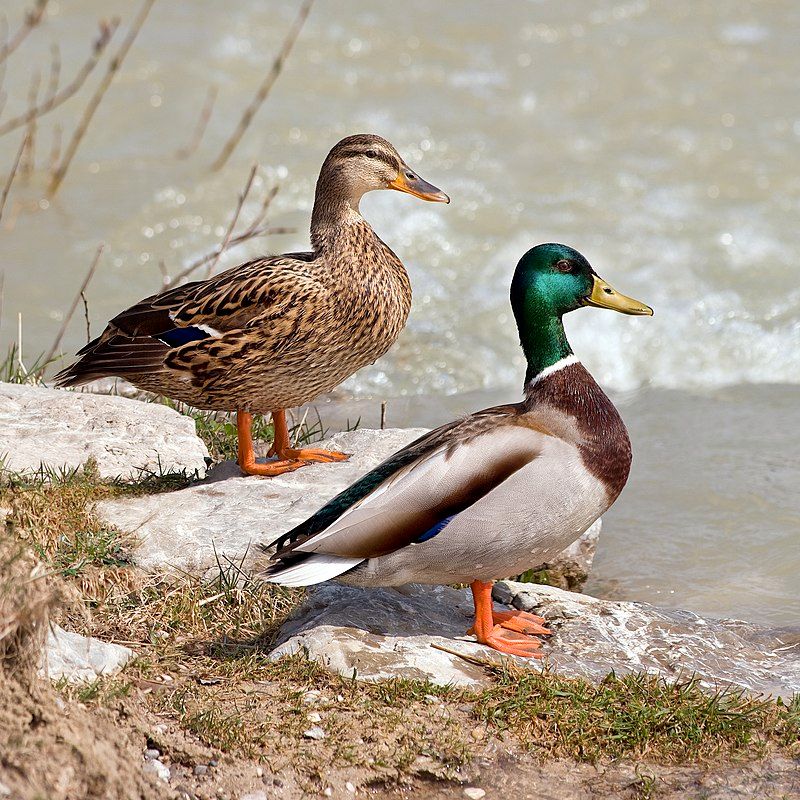
The mallard or wild duck is a species of duck that breeds in a variety of different climates. It is native to the temperate and subtropical climates of the Americas, Eurasia, and North Africa, but has also been introduced to many other parts of the world.
In New Zealand, Australia, Peru, Brazil, Uruguay, Argentina, Chile, Colombia, the Falkland Islands, and South Africa, mallards have been released intentionally or accidentally, allowing them to establish wild populations in areas where they do not naturally occur. Mallards are highly adaptable species and can survive in a variety of different habitats.
They prefer shallow wetlands, such as ponds, marshes, and lakes, but can also be found in open fields and even in urban areas. They are omnivorous and will feed on a variety of plants and animals, including grains, insects, mollusks, crustaceans, and small fish.
Mallards are highly social and often form large flocks. They are also known to hybridize with other species of duck, further increasing their range and adaptability.
| Kingdom | Animalia |
| Phylum | Chordata |
| Class | Aves |
| Order | Anseriformes |
| Family | Anatidae |
| Genus | Anas |
| Species | A. platyrhynchos |
2. Mute Swan
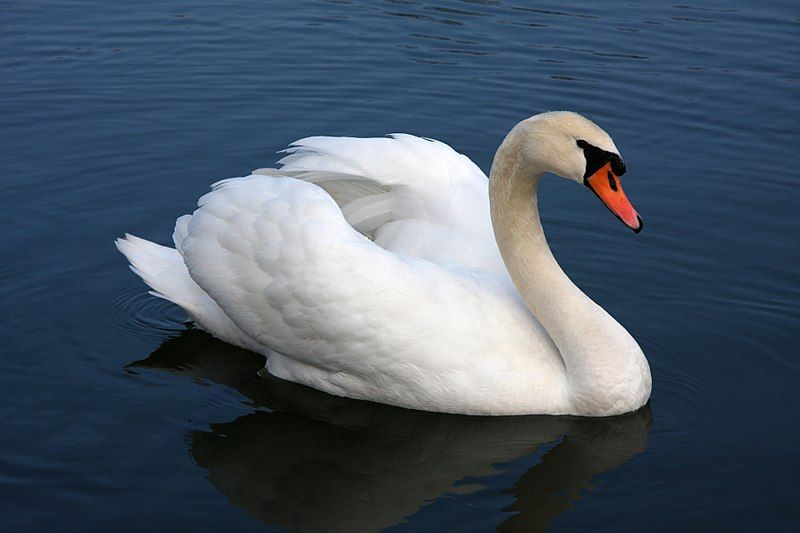
The mute swan is a species of swan that can be found in various parts of the world. It is a part of the Anatidae family, which includes other types of waterfowl such as ducks and geese. This species is native to many parts of Eurasia, from the far north of Europe to Siberia.
It is also found in the far north of Africa. The mute swan is a large bird, typically weighing up to 25 pounds and having a wingspan of up to 7.5 feet. It is easily recognizable due to its white plumage and orange bill.
The species is also known for its graceful swimming and flying abilities. Mute swans are omnivorous, meaning that they eat a variety of food. This includes aquatic plants, fish, insects, and small mammals. They are also known to occasionally consume small birds and eggs.
Mute swans are usually monogamous, meaning that they form long-term pair bonds with one mate. They typically nest in shallow waters, near the shoreline, and will fiercely protect their young.
They are known to be very vocal birds, making various honking sounds, though they are commonly referred to as “mute” swans due to their quietness compared to other swan species. The mute swan is a beautiful and majestic bird, and it is a common sight in many areas of the world.
It is a beloved species, and its presence is often celebrated in various cultures and traditions.
| Kingdom | Animalia |
| Phylum | Chordata |
| Class | Aves |
| Order | Anseriformes |
| Family | Anatidae |
| Genus | Cygnus |
| Species | C. olor |
3. Grebes
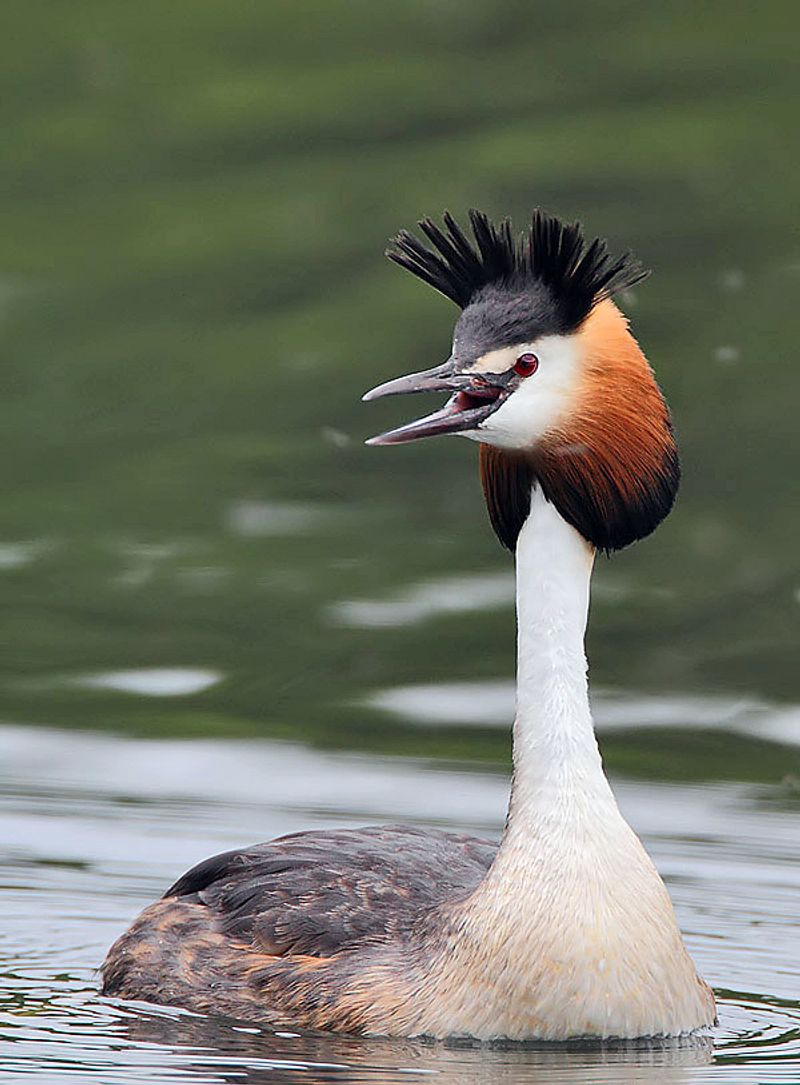
Grebes are a type of aquatic diving bird found in the order Podicipediformes. They are typically found in freshwater habitats, but some species migrate to marine habitats in the winter.
Grebes are generally able to fly, although there are some flightless species that live in more stable lakes. These flightless species are most commonly found in the southern hemisphere, where the climate is milder and the lakes are less subject to freezing temperatures.
Grebes are generally small to medium-sized birds and typically have black and white plumage. They are well adapted to the water, having webbed feet, dense feathers, and a tapered body shape that helps them to swim underwater.
Grebes feed mostly on fish and aquatic invertebrates, but will also eat crustaceans, small amphibians, and aquatic plants. They are important members of aquatic ecosystems, helping to keep populations of fish and invertebrates in check.
| Kingdom | Animalia |
| Phylum | Chordata |
| Class | Aves |
| Clade | Mirandornithes |
| Order | Podicipediformes |
| Family | Podicipedidae |
4. Black-Necked Grebe
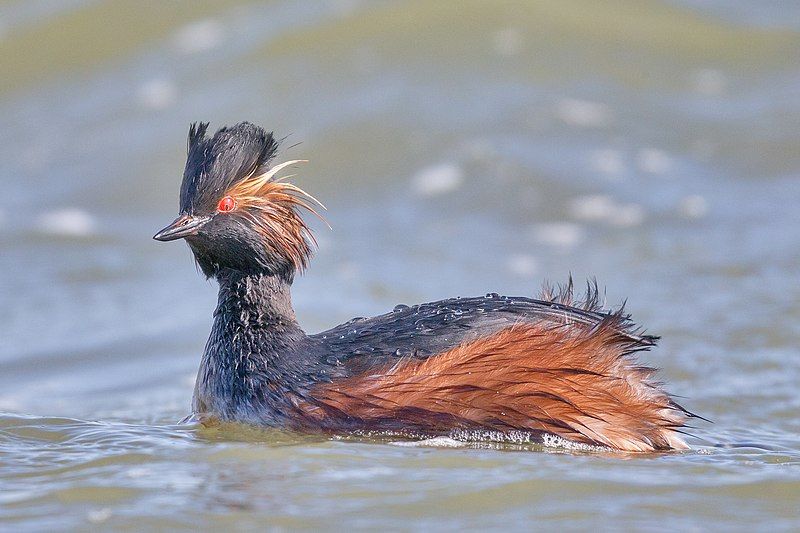
The black-necked grebe or eared grebe is a species of aquatic bird belonging to the grebe family. It was first described in 1831 by German zoologist Christian Ludwig Brehm.
The species is divided into three distinct subspecies, the most widespread and numerous of which is the nominate subspecies. The other two subspecies are the horned grebe and the red-necked grebe, both of which are found in North America.
These two subspecies are known to have slightly different characteristics, such as plumage and size, when compared to the nominate subspecies. The black-necked grebe is a small to medium-sized aquatic bird, measuring around 27-30 cm in length.
It has a black neck and head, white underparts, and a distinctive chestnut strip on its back. This species is known to be quite agile in the water and is often seen diving for food. The black-necked grebe is a social bird and can often be seen in groups.
They feed mainly on small aquatic invertebrates, such as crustaceans and molluscs, as well as some fish. The black-necked grebe is found across the northern hemisphere, inhabiting freshwater or brackish habitats such as lakes, rivers, and wetlands.
It is known to be a migratory species, with the nominate subspecies breeding in Europe and Asia, and both the horned grebe and red-necked grebe breeding in North America.
The black-necked grebe is listed as a species of least concern on the IUCN Red List, as it has a wide range and is not considered to be in any immediate danger of extinction.
| Kingdom | Animalia |
| Phylum | Chordata |
| Class | Aves |
| Order | Podicipediformes |
| Family | Podicipedidae |
| Genus | Podiceps |
| Species | P. nigricollis |
5. Great-Crested Grebe
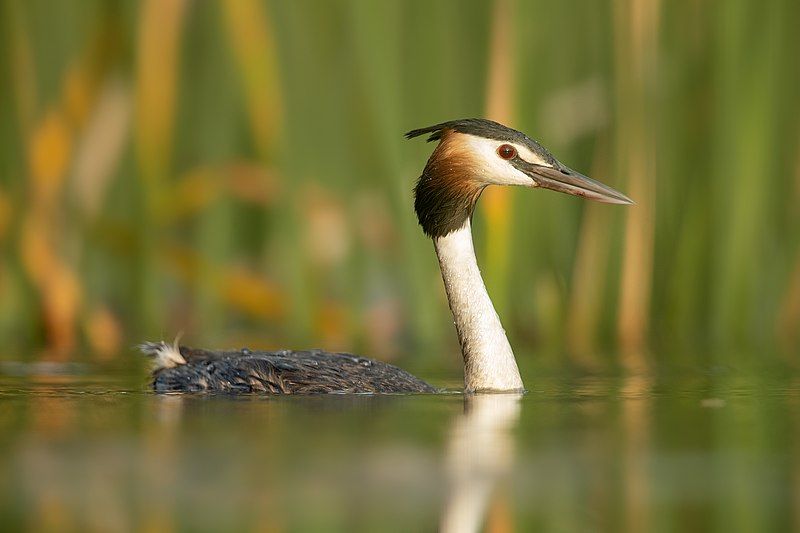
The great crested grebe is a species of water bird that is part of the grebe family. It is an elegant-looking bird with a light brown and black plumage, and it has a distinctive crest on its head.
The great crested grebe is most well-known for its elaborate mating display, which includes a variety of behaviors such as head shaking, bill dipping, and intertwining of necks.
During the display, the two birds will bob their heads in unison while facing each other, and they may also swim in circles around each other. This display is thought to be an important factor in the pair bonding between two great crested grebes.
The mating display typically occurs during the spring and summer months, when the birds are most likely to find a mate and start a family. The great crested grebe is an important species and is found in wetlands and rivers throughout Europe, Asia, and Africa.
| Kingdom | Animalia |
| Phylum | Chordata |
| Class | Aves |
| Order | Podicipediformes |
| Family | Podicipedidae |
| Genus | Podiceps |
| Species | P. cristatus |
6. Cranes
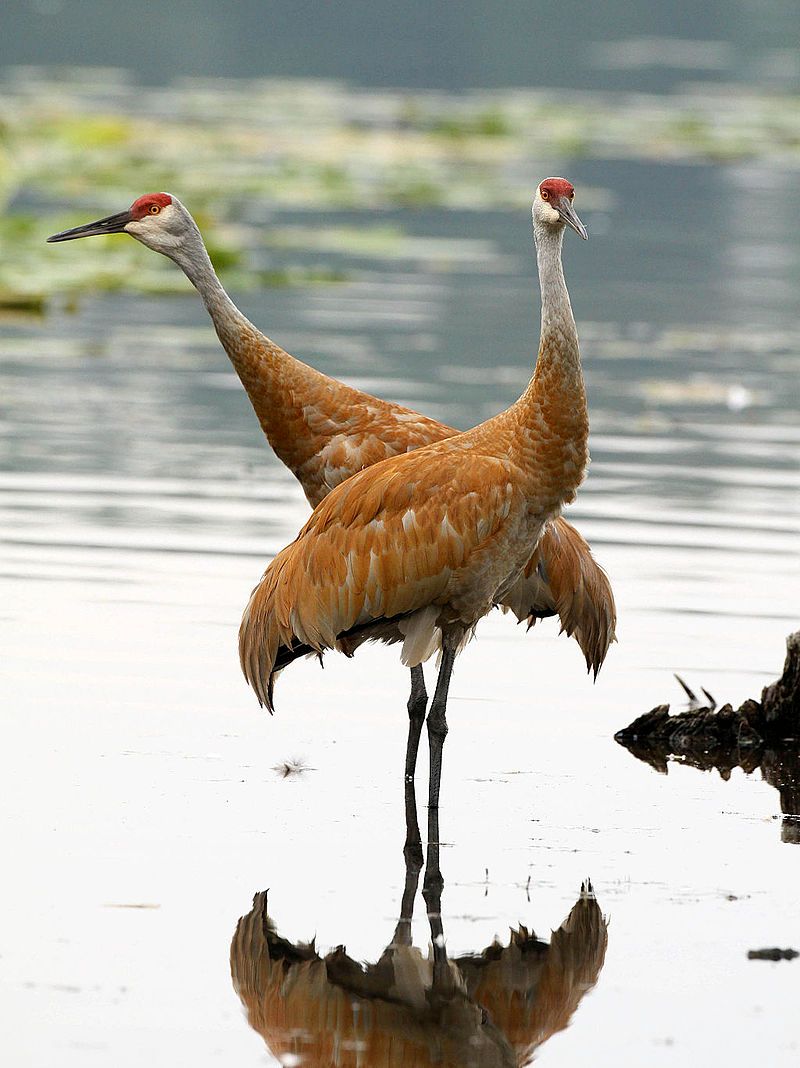
Cranes are a type of bird that belong to the Gruidae family and are classified in the bird group, Gruiformes. They are known for their large size, long legs, and long necks. There are 15 species of cranes that are divided into three genera – Antigone, Balearica, and Grus.
The cranes are often confused with herons, which are similar in appearance, but they are not related. The cranes have the unique ability to fly with their necks outstretched, unlike herons which tend to keep their necks pulled back when flying.
This difference in posture is what sets cranes apart from herons, and is a characteristic that makes them easily recognizable.
| Kingdom | Animalia |
| Phylum | Chordata |
| Class | Aves |
| Order | Gruiformes |
| Family | Gruidae |
7. Common Pochard
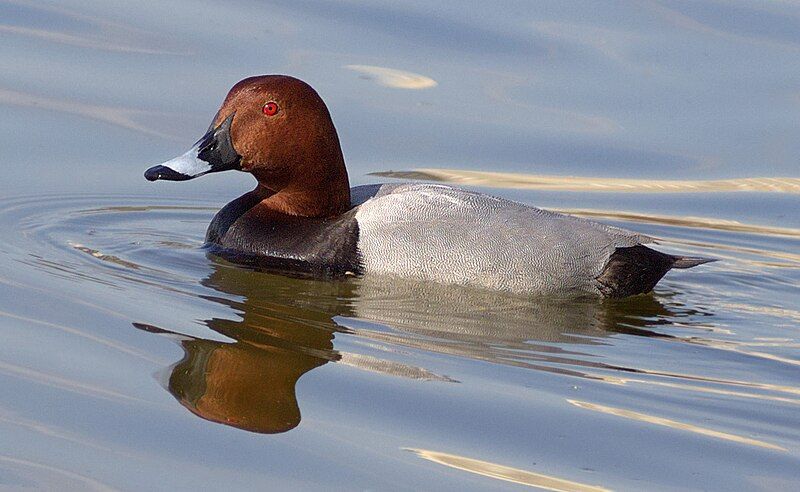
The common pochard is a medium-sized diving duck, and its scientific name is derived from Greek and Latin origins. The Greek word ‘aithuia’ comes from authors including Hesychius and Aristotle, and it refers to an unidentified seabird.
The Latin word ‘ferina’ means ‘wild game’, and this comes from the Latin word ‘ferus’ which translates to ‘wild’. The common pochard is a wild species of duck that has been recognized for centuries, and its scientific name reflects this.
| Kingdom | Animalia |
| Phylum | Chordata |
| Class | Aves |
| Order | Anseriformes |
| Family | Anatidae |
| Genus | Aythya |
| Species | A. ferina |
8. Tundra Swan
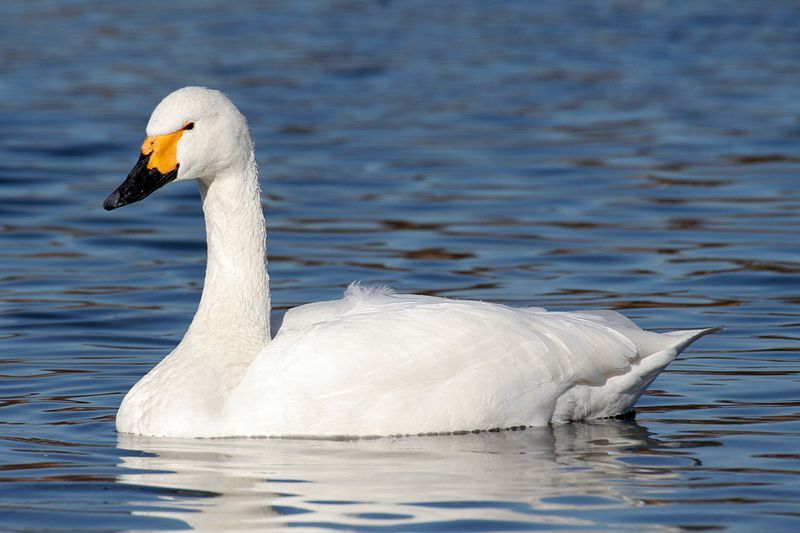
The tundra swan is a medium-sized swan from the Holarctic region, which encompasses the Palaearctic and Nearctic regions.
Taxonomists generally consider the tundra swan to be a single species, but some experts have suggested that it should be divided into two distinct species: Bewick’s swan and the whistling swan.
Bewick’s swan, named after naturalist Thomas Bewick, is found in the Palaearctic region, which includes Europe, Asia, and parts of Africa. It is slightly larger than the whistling swan, and has a yellowish bill with a black base.
The whistling swan, on the other hand, is native to the Nearctic region, which includes North America and Greenland. This species is smaller than Bewick’s Swan and has a completely black bill. It is also known for its high-pitched, melodic whistling call.
| Kingdom | Animalia |
| Phylum | Chordata |
| Class | Aves |
| Order | Anseriformes |
| Family | Anatidae |
| Genus | Cygnus |
| Species | C. columbianus |
9. Whooper Swan
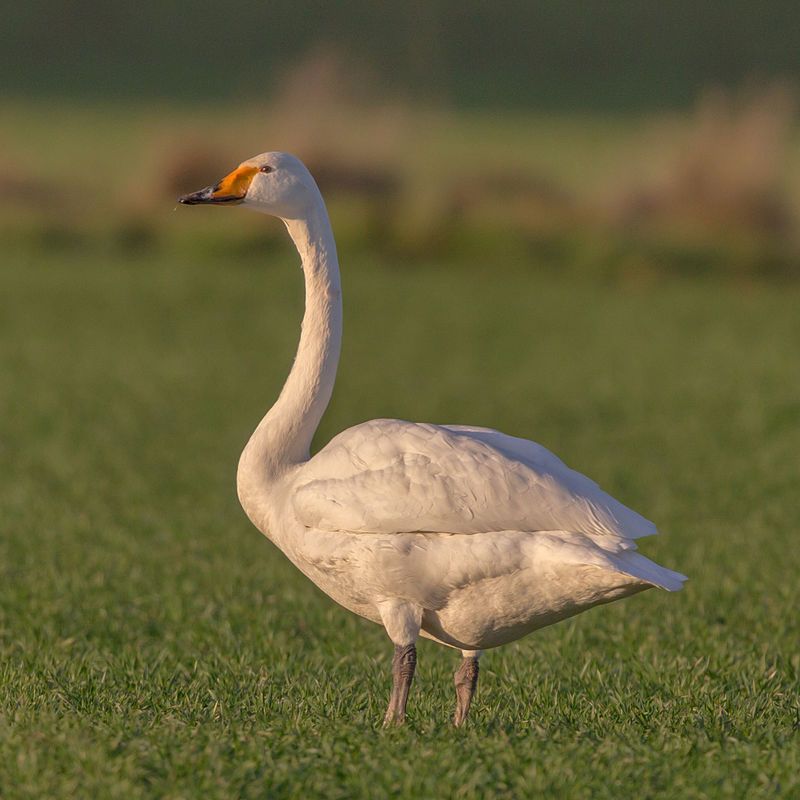
The Whooper Swan, also known as the Common Swan, is a large bird found in the northern hemisphere. It belongs to the genus Cygnus, which is also the type species for this bird. It is mainly found in Eurasia, while its North American counterpart is the Trumpeter Swan.
Whooper Swans are large birds, with a wingspan of up to 2.3 meters. They have long necks and predominantly white plumage, with black and yellow beaks. They are also known for their unique vocalizations, which can be heard from a great distance.
The Whooper Swan is a migratory bird, and their wintering grounds are mainly in the northern parts of Europe and Asia. In the warmer months, they travel to the northern tundra of Canada and Alaska to breed.
They mainly feed on aquatic plants, such as wild celery, water lilies and pondweed. The Whooper Swan is listed as a vulnerable species, due to habitat loss, hunting, and competition with other species for food.
Conservation efforts are underway to protect this species and its habitat.
| Kingdom | Animalia |
| Phylum | Chordata |
| Class | Aves |
| Order | Anseriformes |
| Family | Anatidae |
| Genus | Cygnus |
| Species | C. cygnus |
10. Ruddy Duck
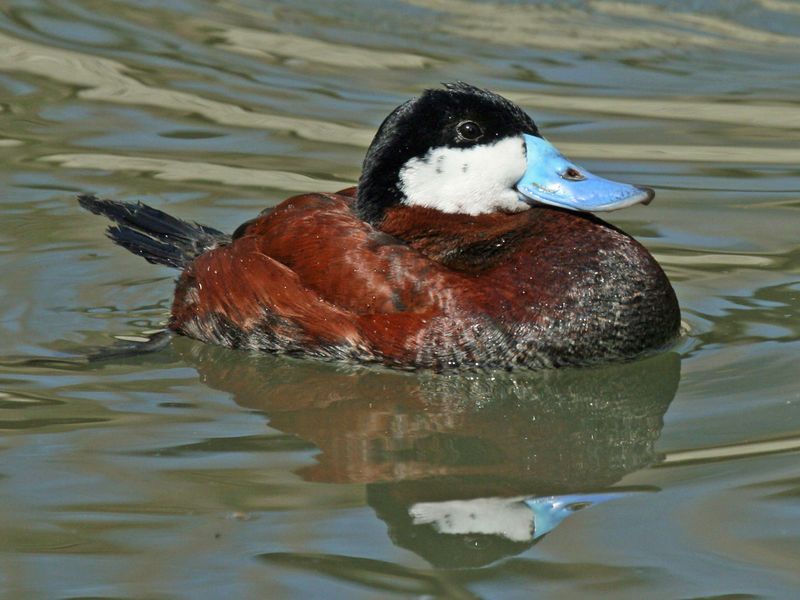
The ruddy duck is a species of duck native to North America and is part of the stiff-tailed duck family. Its scientific name is derived from Ancient Greek, in which oxus means “sharp” and oura means “tail”.
The species name Jamaicensis refers to the fact that it is originally from Jamaica. This species of duck is easily identified due to its distinct reddish colouring on its head, neck, breast, and back. Its tail is also quite unique, as it is quite stiff compared to other ducks.
It has a dark black bill with a blue-grey patch near the base, and its eyes are dark brown. The feet and legs are grey. Ruddy ducks usually live in shallow wetlands, such as marshes, ponds, and lagoons.
They are quite social birds, usually gathering in large flocks during the winter season. During the summer they form small pairs, in which the male will perform a display of raising its tail and wings in order to attract a mate.
Ruddy ducks are omnivores, with their diets consisting of aquatic insects, crustaceans, mollusks, and small fish. They can also be found eating aquatic vegetation, like pondweed and milfoil.
Overall, the ruddy duck is a unique species of duck that can be easily recognized due to its distinct colouration and stiff tail. It prefers shallow wetlands and is quite social, forming large flocks during the winter and small pairs during the summer.
| Kingdom | Animalia |
| Phylum | Chordata |
| Class | Aves |
| Order | Anseriformes |
| Family | Anatidae |
| Genus | Oxyura |
| Species | O. jamaicensis |
11. Water Rail
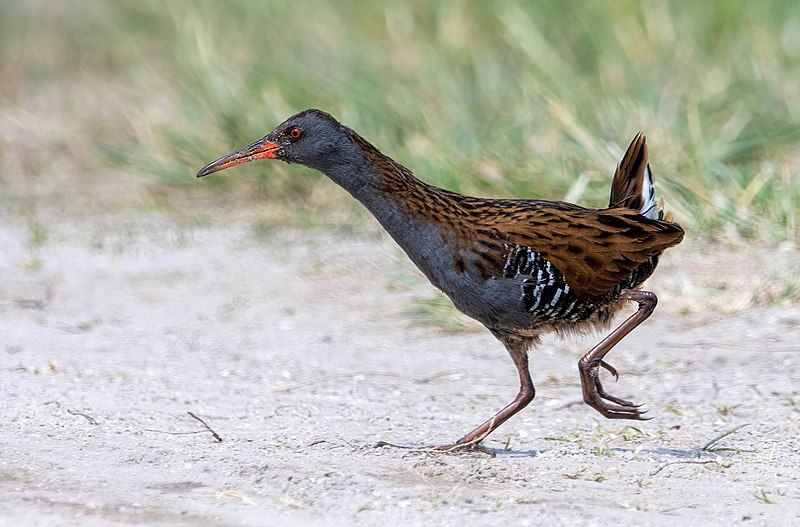
The water rail is a species of bird belonging to the rail family. It is widely distributed across Europe, Asia, and North Africa, inhabiting well-vegetated wetlands and other wet areas.
This species is a migratory bird in its northern and eastern populations, meaning that they migrate to warmer climates during the colder season. In the more temperate areas of its breeding range, the water rail is a permanent resident, remaining throughout the year.
Its wetland habitat is essential for its survival, as it provides food and shelter for the species, as well as a place to breed.
The water rail is an important member of the rail family, and its conservation is of paramount importance, as it plays a vital role in the ecosystems it inhabits.
| Kingdom | Animalia |
| Phylum | Chordata |
| Class | Aves |
| Order | Gruiformes |
| Family | Rallidae |
| Genus | Rallus |
| Species | R. aquaticus |
12. Little Grebe
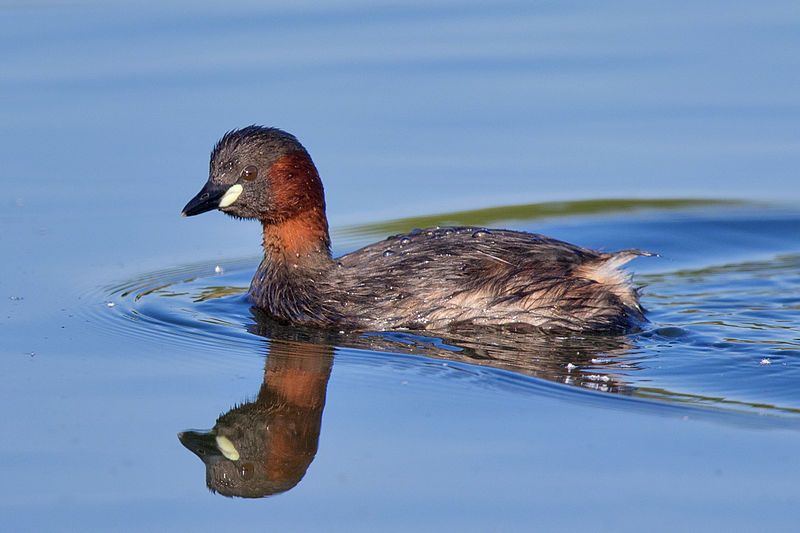
The little grebe, also known as a dabchick, is a water bird belonging to the grebe family. The genus name for the species comes from Ancient Greek, combining the words “takhus” which means “fast” and “bapto” which means to “sink under”.
The species name, ruficollis, is derived from Latin and Modern Latin, with “rufus” meaning “red” and “-collis” derived from “collum” which translates to “neck”. This species is thus characterized by its redneck.
The combination of the Ancient Greek words and Latin words together provides an apt description of these birds that are able to quickly dive under the water and have a distinctive red neck.
| Kingdom | Animalia |
| Phylum | Chordata |
| Class | Aves |
| Order | Podicipediformes |
| Family | Podicipedidae |
| Genus | Tachybaptus |
| Species | T. ruficollis |
13. Eurasian Blue Tit
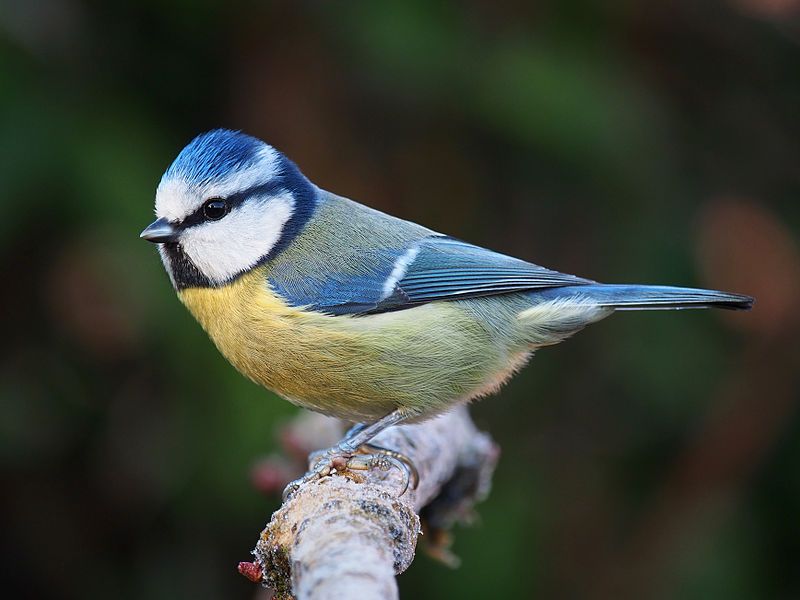
The Eurasian blue tit is a small passerine bird that belongs to the tit family, Paridae. It is found throughout Europe and Asia and is easily recognisable by its bright blue and yellow plumage.
The bird is very small in size, with a body length of around 11-12 cm and a wingspan of 16–19 cm. Its head is blue with a yellow stripe running from the beak to the back of the head, and its back is yellow with a blue line running down the middle.
The wings are mostly blue with yellow edges, and the tail is blue with white and yellow stripes. The underside of its body is white or yellowish. The Eurasian blue tit is mainly insectivorous but also feeds on small fruits, seeds, and other invertebrates.
It is a sociable bird, often found in flocks and often seen in gardens and parks.
| Kingdom | Animalia |
| Phylum | Chordata |
| Class | Aves |
| Order | Passeriformes |
| Family | Paridae |
| Genus | Cyanistes |
| Species | C. caeruleus |
14. Black Stork
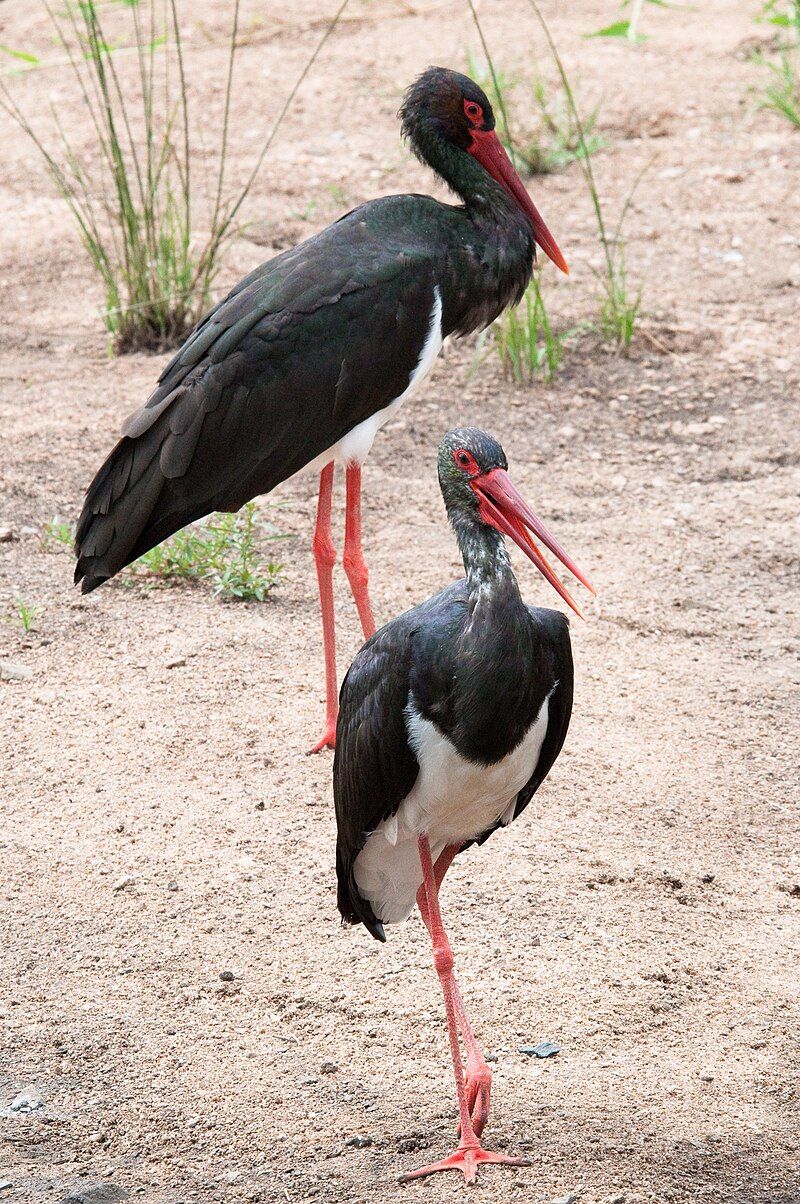
The black stork is a large bird that belongs to the family Ciconiidae, which is a family of wading birds that inhabit tropical and temperate areas worldwide.
This species of stork was first documented by Carl Linnaeus in the 10th edition of his Systema Naturae, which is a systematic catalog of the natural world. The black stork is a large bird, measuring up to 1.2 metres in length with a wingspan of around two metres.
It is mostly black in colour, with a white underside, and has long red legs and a long, curved bill. The black stork is a migratory species, flying south during the winter months to warmer climates, and returning north during the summer months to breed.
The species is found in a variety of habitats, from wetlands and woodlands to open grasslands and even cities. It mainly feeds on amphibians, reptiles, fish and insects, but it will also feed on small mammals and birds.
The black stork is classified as a vulnerable species due to habitat destruction and hunting.
| Kingdom | Animalia |
| Phylum | Chordata |
| Class | Aves |
| Order | Ciconiiformes |
| Family | Ciconiidae |
| Genus | Ciconia |
| Species | C. nigra |
15. Stork
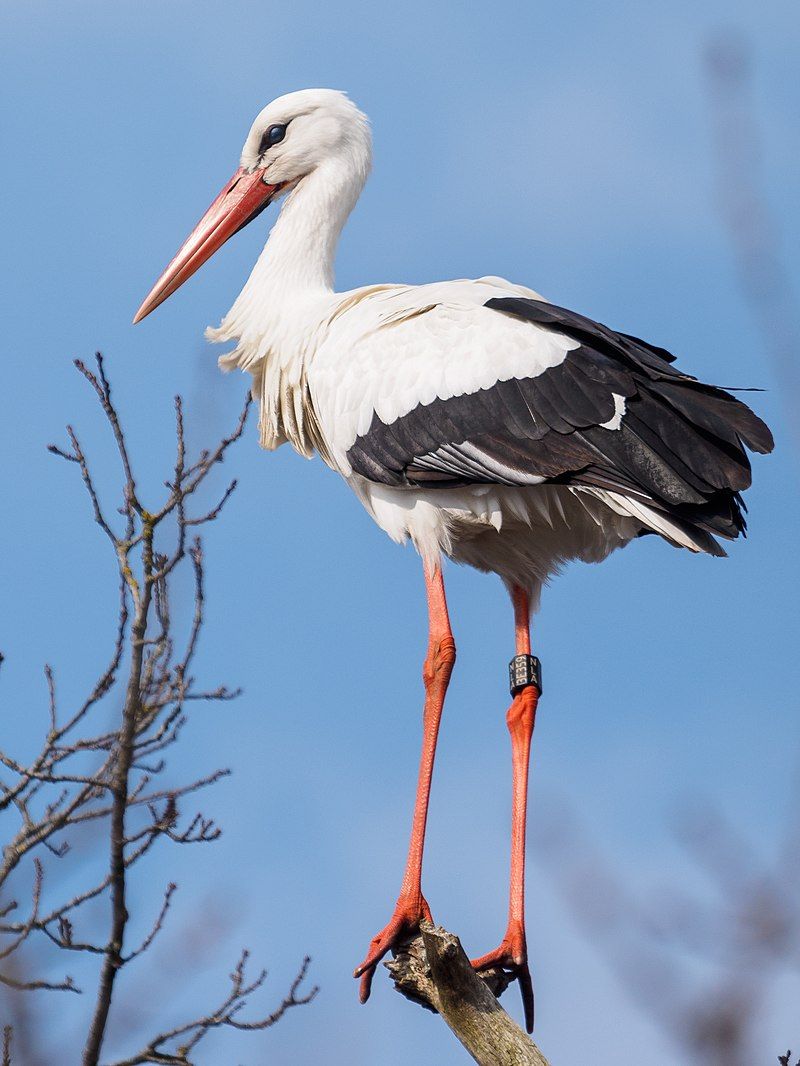
Storks are large birds with distinct features. They have long legs and necks and a stout bill, and they belong to the family Ciconiidae. This can be seen in the order Ciconiiformes, which has been the home of storks for some time.
The Ciconiiformes family previously included other birds like herons and ibises, but they have since been reassigned to other orders. This is because the Ciconiiformes are specifically the order of storks, which are known for their long legs, necks, and bills.
Storks typically inhabit wetland areas, such as lakes, rivers, and marshes. They feed mostly on fish, frogs, and insects. They often stand still in shallow water and wait for prey to come close.
Storks are also known for their distinctive courtship displays, which involve stretching their necks and bill and vibrating their wings. Storks are found on every continent except Antarctica, and there are 19 different species of them.
They usually mate for life and build large nests in trees or on other structures. Storks are important in many cultures, and they are often seen as a symbol of good luck, fertility, and prosperity.
| Kingdom | Animalia |
| Phylum | Chordata |
| Class | Aves |
| Clade | Aequornithes |
| Order | Ciconiiformes |
| Family | Ciconiidae |
16. Eurasian Bittern
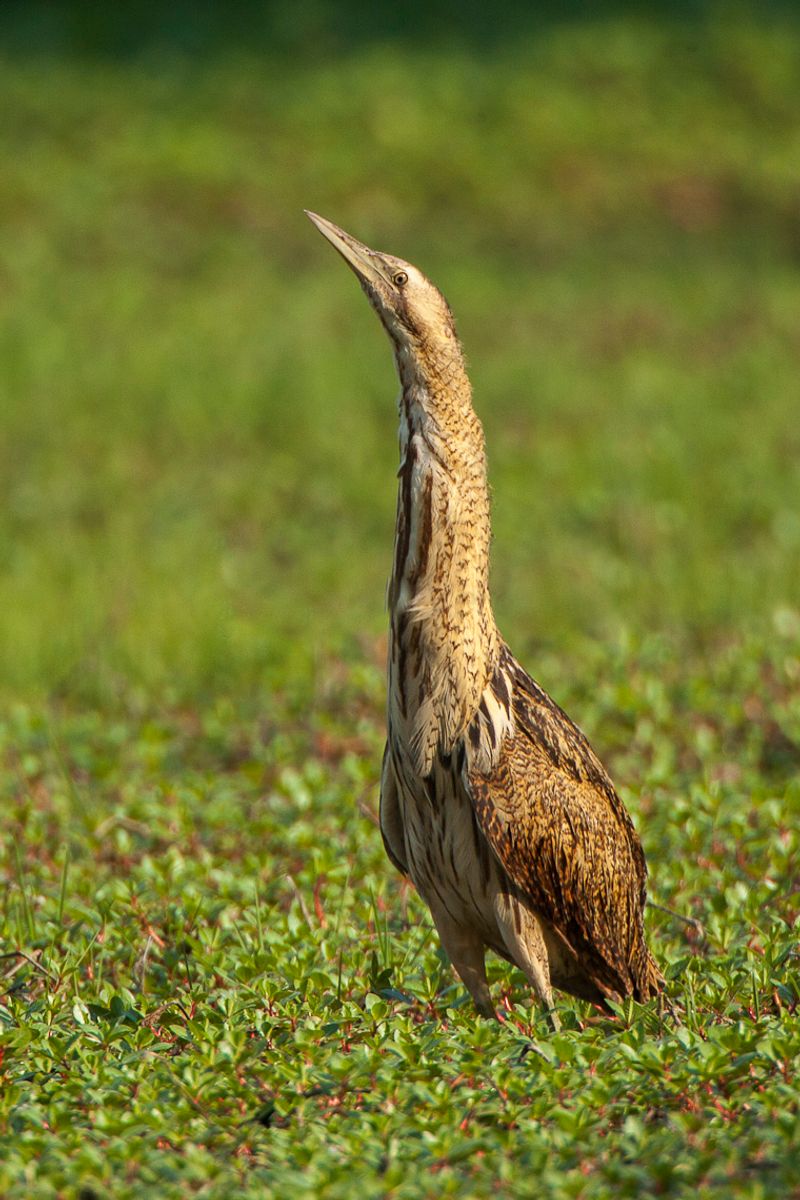
The Eurasian bittern, also known as the great bittern, is a large wading bird belonging to the heron family (Ardeidae) and the bittern subfamily.
It has two distinct subspecies – the northern race is found throughout Europe, the Palearctic region and on the northern coast of Africa, while the southern race is endemic to parts of southern Africa. The Eurasian bittern is a large bird with a light brown and white mottled plumage, and a long neck and bill.
It is most active at twilight and night when it hunts for fish, amphibians, crustaceans and insects. During the day, it remains still in marsh vegetation, relying on its camouflage to hide from predators.
Eurasian bitterns typically breed from March to June, when the male performs a ‘ booming’ display to attract a mate. The female builds a large nest in dense vegetation and lays up to six eggs. The chicks are fed by both parents and fledge after about three weeks.
Overall, the Eurasian bittern is an iconic species of the wetlands, with its unmistakable booming call providing a soundtrack to the marshlands. It is a species of conservation concern, as its populations have declined due to habitat loss and other human-induced pressures.
| Kingdom | Animalia |
| Phylum | Chordata |
| Class | Aves |
| Order | Pelecaniformes |
| Family | Ardeidae |
| Genus | Botaurus |
| Species | B. stellaris |
17. Little Bittern
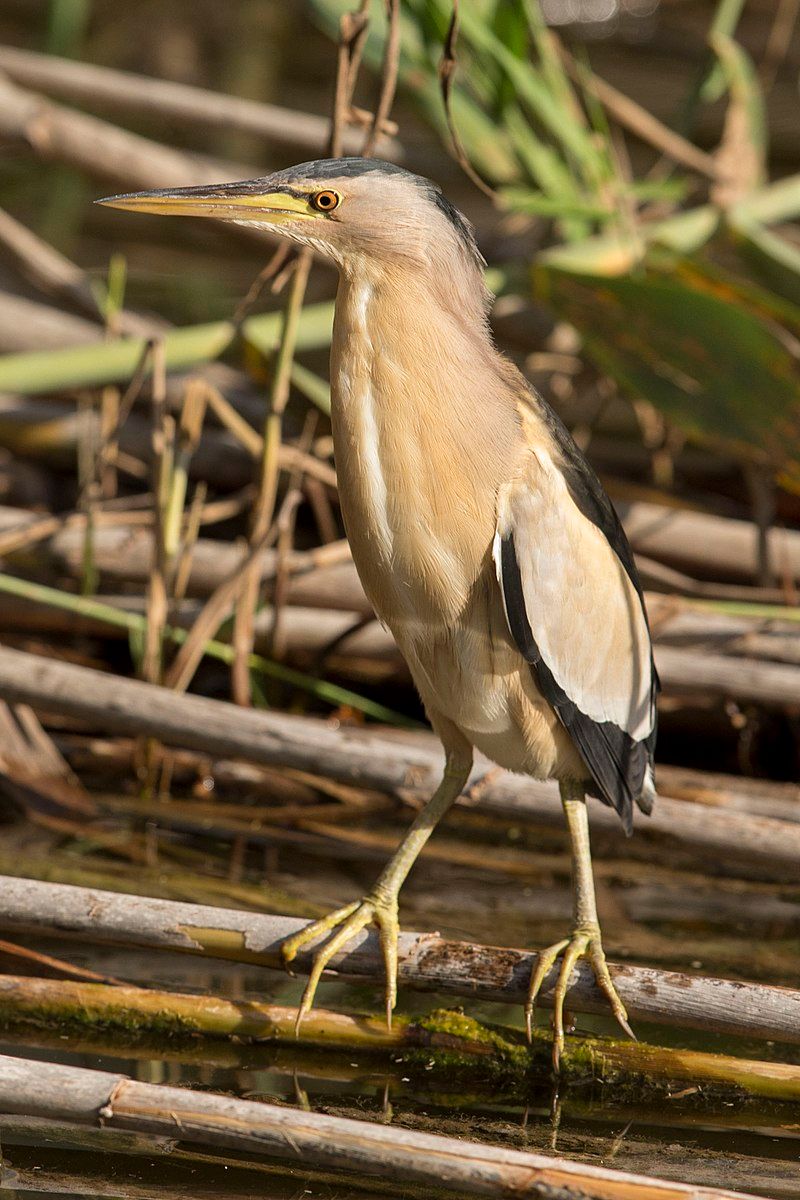
The little bittern, also known as the common little bittern, is a species of wading bird found in the heron family, Ardeidae. It is a small bird, and its scientific name, Ixobrychus minutus, is derived from Ancient Greek and Latin words.
The first part of the name, Ixobrychus, comes from the Greek words ixias, which means a reed-like plant, and brukhomai, which means to bellow. The second part, minutus, is Latin for “small”. This bird is aptly named for its small size and affinity for reed beds.
The little bittern can be found in wetlands, marshes, and other wet grassy areas across much of Europe, Africa, Asia, and Australia.
It is a solitary bird and can often be seen standing motionless in the reeds, relying on its cryptic colouration to blend in with its surroundings. Its diet consists mainly of small fish, frogs, insects, and other invertebrates.
It is a relatively small bird, measuring only about 28 cm in length. The little bittern has become a conservation concern due to the destruction of wetland habitats. It is now listed as a species of Least Concern by the International Union for Conservation of Nature (IUCN).
Despite this, its population has been declining steadily over the past few decades, and conservation efforts are needed to ensure its survival in the future.
| Kingdom | Animalia |
| Phylum | Chordata |
| Class | Aves |
| Order | Pelecaniformes |
| Family | Ardeidae |
| Genus | Ixobrychus |
| Species | I. minutus |
Conclusion
Saxony-Anhalt is a great place for bird-watching. With a rich variety of species, habitats, and birding locations, it is a great destination for birdwatchers of all levels.
There are many protected areas and reserves in the region, ensuring that the birds of Saxony-Anhalt remain safe and flourish for years to come.